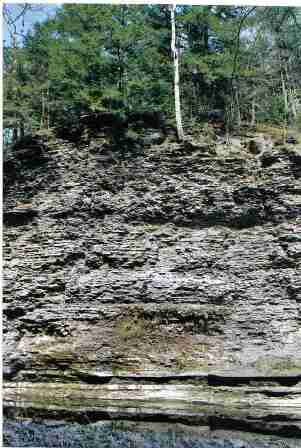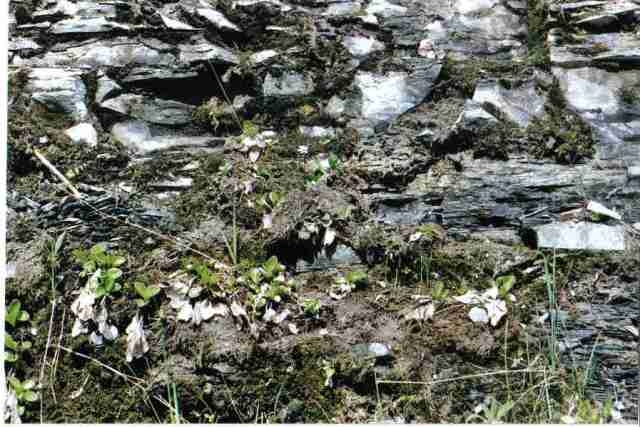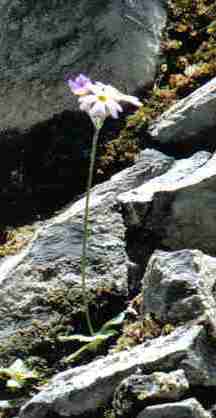Maybe so, but we can still see the results in areas with vertical cliffs. We can see water seeping right out of a cliff face.
I thought everyone might like these pictures of a cliff side community.
The first picture shows the entire cliff. Water is seeping out of the limestone in the bottom center of the picture just above a harder less permeable layer.
The second picture shows the community of plants that resides on this West facing cliff seep.
The third picture is a closeup of Primula mistassinica from this cliff side seep community. If you look closely you will be able to find this plant in the center of the second photo.
I was never sure about the identification of the other vascular plant species shown in the photo. One appears to be a Parnassius.
Sincerely,
James




Comments
Anonymous (not verified)
Re: Cliff Seep Community
Sun, 01/08/2012 - 8:51pmI have a lot of cliff pictures. Since we started talking about Rhodiola on "image of the day" I decided to post these pictures. This is one plant of R. integrifolia ssp. leedyi just starting to bloom and a picture showing the habitat. The cliffs are composed of shale. This picture was taken only a mile or two from the previous set with Primula mistassinica. The cliff faces East. No cold air was observed coming from these cliffs. These pictures were taken in a cold Spring rain. I visited the site a second time in Summer when it was drier. I do not remember observing seepage at that time. I think this population is maintained by the cooling effect of the large heat sink created by Lake Seneca. If this plant will grow in this location, then I am sure there are thousands of miles of habitat along the Great Lakes where it could succeed.
FYI I would suggest not visiting this site in summer. Algae grows on the rocks at the base of the cliff as the water temperature warms. It was so slick my camera and I almost went swimming on this later visit. Spring is a much better time because the algae has not yet grown.
Most of the pictures of R. rosea show pale yellow flowers that are not nearly as attractive to myself as the flowers of R. integrifolia. When I was on Kodiak Island what they called R. rosea had flowers that were more of a red.
Either one of the U.S. Fish and Wildlife Service, the State of Minnesota, the State of New York, or the land owners would probably not grant the permission necessary to bring this subspecies into cultivation. Luckily seed is often available of other R. integrifolia subspecies. If anyone happens upon a particularly showy form of R. rosea, that would be nice too.
It would be good to see some effort put into identifying new potential habitat and trying to establish some more stations for Leedy's Roseroot. This would help preserve the species. Especially considering entire cliff faces, where this species occurs, do occasionally collapse. The problem would not be doing the work, it would be getting the permission.
James
Trond Hoy
Re: Cliff Seep Community
Mon, 01/09/2012 - 1:42pmInteresting, James. Why do you think it is difficult to get necessary permissions from private people?
Here you have a batch of "rosenrot" from north in Norway:
Picture: Tor Harry Bjørn
I have borrowed the picture from this site http://www.bio-bjorn.no/photogallery/gallery.asp?gallery=9.Natur-diverse...
Take a look! It is a lot of great pictures!
Anonymous (not verified)
Re: Cliff Seep Community
Mon, 01/09/2012 - 5:42pmI am sure most of the populations are owned by public agencies or private conservation organizations. Getting permission from a private landowners can be difficult. Some are welcoming, some don't care, but others would not let you on their property unless it was over their dead body.
James
Tim Ingram (not verified)
Re: Cliff Seep Community
Tue, 01/10/2012 - 5:59amJames - I must admit if I had a cliff like that in my garden I would probably take it over for all sorts of non-native plants! It makes a fascinating habitat.
Trond - wonderful pictures! They remind of some of the Wilderness pictures taken in Tasmania; often very simple images but really capturing the 'place'. It's hard not to want to head for the hills...
Trond Hoy
Re: Cliff Seep Community
Tue, 01/10/2012 - 6:43amI don't think it had been easy to get permissions to do something to red-listed plants here either but I know it has been done. On the other hand we have the right to walk almost everywhere on other man's property unless it is farmland with crop. We can also tent on other man's land for one night without asking.
Richard T. Rodich
Re: Cliff Seep Community
Tue, 01/10/2012 - 7:37amFrom the U.S. Fish and Wildlife Service:
The majority of Leedy's roseroot populations occur on privately-owned land. Only two of the six populations occur on public land, one in Watkins Glen State Park, New York and one in Whitewater Wildlife Management Area, Minnesota.
http://www.fws.gov/midwest/Endangered/plants/leedysro.html
And the Watiins Glen State Park site consists on just one (1) plant.
"Privately own" could also mean it is held by a private conservation organization, I suppose. In Minnesota, however, transfer to the public domain from such organizations like the Nature Conservancy is usually rather expedient, and it hasn't happened yet.
Richard T. Rodich
Re: Cliff Seep Community
Tue, 01/10/2012 - 7:46amWow, that would NEVER happen here! It would be a miracle if all (or even most) Americans actually respected other people's land while they use it. Most wild properties here are posted with "No Hunting", "No Trespassing", No Trapping", "No Dumping" signs and the like, simply to protect themselves as the legal landowner. Without posting such signs, prosecution for illegal dumping or trapping, etc., although very easy on public land, is very difficult on private property.
Trond Hoy
Re: Cliff Seep Community
Tue, 01/10/2012 - 8:26am"Allmannaretten" (all men's right) is strong in Norway, from old times. Although we have the right to walk, we do not have the right to fish, hunt, trap, dump etc wherever we wish. Hunting and fishing rights can be bought or leased but you can't dump stuff, dig or build anything even on your own land without permission. It is however not necessary with signs to tell people, you are expected to know it! The problem with a prosecution is to prove who offended the law.
Anonymous (not verified)
Re: Cliff Seep Community
Tue, 01/10/2012 - 9:13pmI never did find that one plant at Watkin's Glen. Although, I was assured it is still there. The population I photographed was donated to the Finger Lakes Land Trust. Although, smaller numbers occur on private property which is further South along this same cliff face. Stairways have been cut through the cliffs in some locations so people can access boat houses. This has not seemed to impact the Leedy's Roseroot significantly. Protection of these few colonies on private property is probably not a huge priority because the high bluff and cliff face do the job better than a deed. I hope other land owners feel compelled to donate their tiny slice of property which contains this unique habitat. Since it is a cliff, when you measure the area from above the square feet (meters) involved is surprisingly tiny.
The bluff above this cliff face is really high. It is shaded by hemlock. It is possible cold air seeps under these hemlocks cooling the cliff face. However, I did not observe any cold air vents.
There are easements which allow people to travel through private land to access public property or their own property. However, people do not have the right to unlimited access to private land. When hiking in the Adirondacks you must travel through land owned by the Rockerfellers or Fords to climb peaks which are on State land. Even though the law allows for this easement, I do not take it for granted. Private property owners have been known to prevent people from using their legal access rights. This happened to a peak outside Phoenix, Arizona after a developer purchased State Trust Lands. It took years of legal work and public outrage to reopen this access.
Since this thread is about cliffs, I will include some pictures from Watkins Glen. Has this thread made anyone else want to construct a cold air slope in their gardens?
James
Trond Hoy
Re: Cliff Seep Community
Tue, 01/10/2012 - 11:34pmSuch incidents are rare here but when I was a kid it was difficult to walk along the shores many places as the landowners had fences along their property borders. Now all those fences are removed or made possible to pass through.
All my slopes are cold air slopes ;)
Tim Ingram (not verified)
Re: Cliff Seep Community
Wed, 01/11/2012 - 12:06pmJames - brilliant pictures of Watkins Glen. This must be an amazing place to explore botanically and geologically. I can imagine it being used in a Tolkeinesque mythology!
Anonymous (not verified)
Re: Cliff Seep Community
Sun, 01/22/2012 - 7:21amI found some pictures of Leedy's Roseroot taken at the end of May. The pictures show the blooms more open. I am posting them here for your pleasure.
If you look at where this plant chooses to grow on the cliff, you will notice it is almost always under the protection of an over hanging ledge. It seems like the plant is trying to seek cover from hail storms. It does choose a rather precarious habitat. While photographing these plants I did notice a small individual floating in the waters of Lake Seneca. This little fellow must have by chance grown in a location that was just a little too exposed.
Hail storms were surprisingly common during my plant adventures at this time of year. At Taughannock Falls a ranger drove up the access road and told me there was a Tornado Warning. She tried to press me to leave, but I honestly could not think of a safer place to be than at the bottom of a deep gorge.
While driving home I often ran into hail storms that were so vicious I had to pull my car off the highway. Not only to minimize damage to my car, but as because I could not see beyond my bumper. Often while I was waiting for the storm to pass my wife would call to tell me they had just issued a tornado warning for the exact area where I was parked. There was nothing much I could do about the situation at that point.
I never did get hit by a tornado, at least ... not yet. Considering I resided in Nebraska during all my grade school years, it would have been a shame if a Tornado had gotten me right after relocating to the East.
James
cohan (not verified)
Re: Cliff Seep Community
Thu, 02/09/2012 - 4:04pmVery interesting place, James! And interesting set of conservation issues.. let us know if you learn anything else, or are able to get seeds, etc..
In my immediate area, all land is private land, apart from roadways and the ditches beside them (even then, depending on the individual spot and how road construction and subsequent fence building went, the ditches/roadsides may extend into private property) and there is certainly no expectation that you can walk on anyone else's property without permission! While doing my roadside botanising, I rarely extend anything more than a camera lens over the fence onto someone's property (since typically, I don't even know whose property it is- houses can be as little as 1/4 mile apart, up to several miles, and you never know if their house is at the end of the property or in the middle, or land can be owned or leased by someone living some distance away, etc, so asking permission would be complicated, and I would only do it for really special sites- haven't made any attempt so far!). Their is a site not far away with no fences and no 'No Trespassing' signs where I have gone a few metres beyond the roadside to photograph a rich plant community and collect some seed, and another site where I crossed a fence to collect seed of Delphinium glaucum- being fairly sure the landowner would be happy to have fewer of these poisonous plants growing in a pasture...lol But in any case- If I'm so much as leaning across a fence, I make sure to keep an ear open for any approaching vehicle that might have a suspicious land-owner in it..lol
Once into the foothills and mountains, its mostly public land- parks/wilderness areas etc which you can usually access with various constraints, and are protected to varying degress, and also provincial forestry land, which you are allowed to travel around on, and can get permits for things like cutting firewood or christmas trees, or digging seedling trees for transplanting!
Trond Hoy
Re: Cliff Seep Community
Fri, 02/10/2012 - 2:40pmI am very glad I never need to bother who is the owner of a property. As long as I don' tread on farmland with vegetables or in a cornfield or in the garden next to a house I can walk whereever I want!
cohan (not verified)
Re: Cliff Seep Community
Fri, 02/10/2012 - 10:47pmPeople here are not nearly so accomodating...lol.. even staying in the ditches I get some very funny looks! If I am riding my bike they probably think I'm weird but recognise it as exercise, I guess... if I am walking, they think my car must have broken down, and some people seem to think I may be looking to commit some crime- maybe because I am without a vehicle they think I am going to steal one?? lol